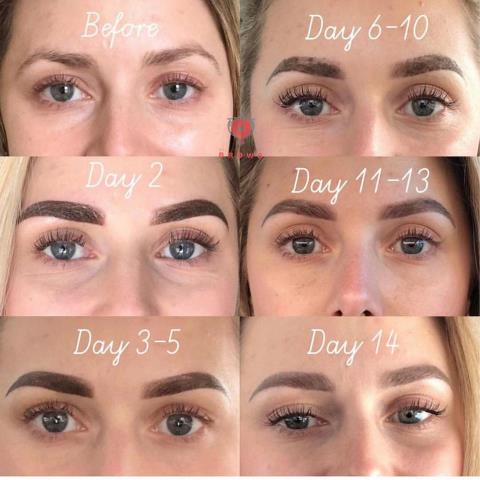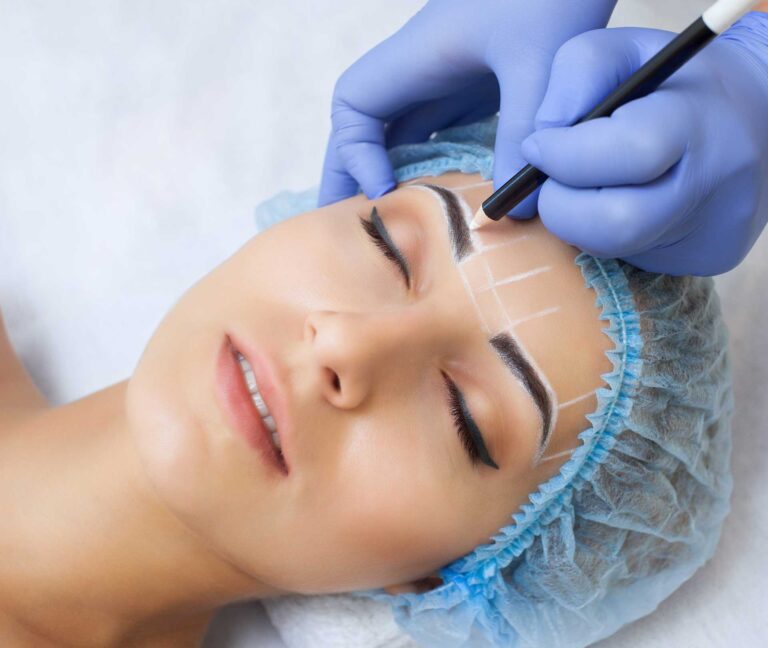Get personalized Consultation!
Microblading
Microblading has quickly become a go-to method for enhancing eyebrows, allowing individuals to achieve the perfect shape and thickness.
In this article, we will explore the origins of microblading, its evolution, and the surge in its popularity in recent years.

Definition and Origin of Microblading
Microblading is a semi-permanent cosmetic procedure used to enhance the appearance of eyebrows. This technique originated in Asia, specifically in Japan and South Korea, where it was known as “eyebrow embroidery.” It has since gained popularity worldwide as a highly effective method of achieving natural-looking eyebrows.
The Evolution of Eyebrow Enhancement
From the ancient Egyptians using kohl to define their eyebrows, to the more recent trend of eyebrow tattooing, people have always sought ways to enhance their brows. However, traditional tattooing often resulted in unnatural and harsh-looking eyebrows. Microblading, on the other hand, provides a much more realistic and subtle effect.
The Popularity Surge in Microblading
The popularity of microblading has skyrocketed in recent years. With the rise of social media and the influence of celebrities, more and more people are seeking out this procedure to achieve the perfect set of eyebrows. The natural-looking results and the convenience it offers have contributed to its surge in popularity.
Understanding Microblading
To truly appreciate the benefits of microblading, it’s important to understand what this procedure entails and how it differs from traditional tattooing.
What is Microblading?
Microblading is a meticulous and precise procedure that involves creating tiny, hair-like strokes on the eyebrow area using a handheld tool with microblades. The artist carefully implants pigment into the skin’s upper layers, resulting in defined and natural-looking brows.
Overview of the Procedure
Before the actual microblading process begins, the artist and client discuss the desired shape and thickness of the brows. Once the client is satisfied with the proposed design, the artist starts the procedure by numbing the area and then manually creating the hair strokes.
How Microblading Differs from Tattooing
Microblading differs from traditional tattooing in several ways. Unlike tattooing, which uses a machine to deposit ink deep into the skin’s layers, microblading only penetrates the upper layers. This results in a more temporary effect, lasting up to two years, allowing for adjustments to be made as facial features change over time.
Anatomy of the Eyebrow
Understanding the structure of the eyebrow is crucial in achieving the best results through microblading.
Understanding Brow Structure
The eyebrow is composed of the brow bone, follicles, and natural hair. Microblading enhances the shape and thickness of the existing brow by filling in sparse areas and creating defined strokes that mimic natural hair.
The Role of Microblading in Enhancing Features
Microblading can do wonders in framing and enhancing facial features. By creating well-defined eyebrows, this procedure can help balance and harmonize the overall appearance of the face, bringing out the best in each individual.

Benefits of Microblading
Microblading offers numerous benefits that make it an attractive option for those seeking a semi-permanent eyebrow enhancement solution.
Natural-Looking Results
One of the key advantages of microblading is the ability to achieve natural-looking results. The meticulous technique used in this procedure allows for precise strokes that mimic natural hair, creating the illusion of fuller and well-defined eyebrows.
Time-Saving Beauty Routine
For individuals who spend precious time each day filling in and shaping their brows, microblading offers a significant time-saving advantage. Waking up with perfectly shaped eyebrows eliminates the need for daily eyebrow maintenance, allowing individuals to focus on other aspects of their beauty routine.
Boost in Confidence
Well-shaped and defined eyebrows can have a transformative effect on an individual’s overall appearance. Microblading can significantly boost confidence by providing individuals with brows that frame their face in a flattering way, enhancing their natural beauty.
Tailored to Individual Face Shapes
Microblading takes into account the unique characteristics of each individual’s face shape. The procedure is customized to suit the natural symmetry and contours of the face, ensuring that the end result is harmonious and flattering.
Longevity of Results
While microblading is considered a semi-permanent procedure, the results can last up to two years. This longevity is a significant advantage for individuals looking for a long-lasting solution to their eyebrow enhancement needs.
Finding the Right Microblading Artist
Choosing the right microblading artist is vital to achieve the desired results and ensure a safe and hygienic experience.
Importance of Research and Recommendations
Before making a decision, it is essential to research and gather recommendations from trusted sources. Reading reviews and testimonials can provide insights into the expertise and professionalism of the chosen artist.
Reviewing Portfolios and Credentials
A reputable microblading artist will have a portfolio showcasing their previous work and certifications that demonstrate their skill and training. Taking the time to review these portfolios and credentials can give peace of mind and confidence in making the right choice.
Initial Consultation and Patch Test
It is crucial to have an initial consultation with the chosen artist to discuss expectations, assess the suitability of the procedure, and address any concerns. Additionally, a patch test should be performed to ensure the client is not allergic to the pigments used during microblading.
Preparing for Microblading
Proper preparation before the microblading procedure can contribute to optimal results and a smoother overall experience.
Pre-Procedure Skincare Guidelines
The skin in the eyebrow area should be prepared adequately before the procedure. This includes avoiding the use of retinol or exfoliating treatments, as these can cause irritation or thinning of the skin. Additionally, sun exposure and tanning should be avoided, as it can affect the pigmentation process.
Discussing Desired Brow Shape and Style
During the pre-procedure consultation, it is crucial to discuss the desired brow shape and style with the microblading artist. Bringing reference images and having open communication can ensure that the final result aligns with the client’s vision.
Managing Expectations and Potential Discomfort
It is important to manage expectations before the procedure. While microblading is generally well-tolerated, some discomfort may be experienced during the process. Informing the client about the sensations they may feel and providing reassurance can help alleviate any potential concerns.
The Microblading Process

Understanding the step-by-step process of microblading can provide a clear picture of what to expect during the procedure.
Step-by-Step Overview
- Consultation: The artist discusses the client’s expectations and desired outcomes.
- Brow Mapping: The artist measures and outlines the ideal brow shape and symmetry.
- Numbing: A topical anesthetic is applied to minimize discomfort.
- Microblading: Using a handheld tool with microblades, the artist creates hair-like strokes and deposits pigment into the skin.
- Pigment Adjustment: The pigment color and intensity can be adjusted to achieve the desired shade.
- Final Touches: After the microblading is complete, the artist examines the results and makes any necessary final adjustments.
Customizing Pigment Color and Brow Shape
One of the advantages of microblading is the ability to customize the pigment color and brow shape based on the client’s preferences. The artist carefully selects the pigment that most closely matches the client’s natural hair color, ensuring a seamless and natural look.
Numbing Process and Sensation During Microblading
To ensure maximum comfort during the procedure, a topical numbing cream is applied to the eyebrow area. While some clients may still experience slight discomfort or a scratching sensation, the numbing cream helps minimize any potential pain.
Post-Microblading Care and Healing
Proper aftercare is crucial in the healing process and to ensure the longevity of the microbladed eyebrows.
Immediate Aftercare Instructions
Following the microblading procedure, the artist provides detailed aftercare instructions. These instructions typically include avoiding excessive moisture, sun exposure, and touching the treated area. Applying a designated aftercare product and gently cleansing the brows are also part of the aftercare routine.
Reducing Swelling and Discomfort
It is normal to experience some swelling and discomfort immediately after microblading. Applying cold compresses and avoiding salty and spicy foods can help reduce swelling. Over-the-counter pain relievers can also be used as recommended by the microblading artist.
Long-Term Maintenance Tips
To prolong the results of microblading, it is essential to follow the recommended maintenance guidelines. Regular touch-ups are usually required to maintain the shape and color of the brows. Additionally, protecting the eyebrows from excessive sun exposure and avoiding harsh skincare products can help preserve the pigment.
Addressing Common Concerns and Myths
Addressing common concerns and dispelling myths surrounding microblading can help individuals make informed decisions.
Pain Level Associated with Microblading
While microblading may cause slight discomfort, the topical numbing cream used before the procedure helps minimize any potential pain. The sensation has been likened to a scratching or light stinging feeling.
Risks and Side Effects
Like any cosmetic procedure, microblading does carry some risks and side effects. These can include mild redness, swelling, and scabbing in the treated area. However, with proper aftercare and an experienced artist, these side effects are typically minimal and resolve quickly.
Dispelling Common Misconceptions
There are several misconceptions surrounding microblading that need to be addressed. Some believe that microbladed eyebrows look unnatural or fade quickly, but with advancements in pigment and technique, these concerns have largely been put to rest.
Do's and Don'ts
To ensure the best results and minimize any potential complications, there are certain do’s and don’ts that individuals should adhere to.
- Do follow the aftercare instructions provided by the microblading artist.
- Don’t scratch or pick at the treated area, as this can disrupt the healing process and affect the results.
- Do book and attend the recommended touch-up sessions to maintain the desired shape and color.
- Don’t expose the freshly microbladed eyebrows to excessive moisture, sunlight, or harsh skincare products.
Microblading at Vida Skin and Hair Transplant Clinic offers clients a chance to enhance their eyebrows with a natural-looking and long-lasting result. By understanding the procedure, benefits, and aftercare, individuals can make an informed decision and achieve the perfect set of brows that will boost their confidence and save them time in their beauty routine. So, why wait? Book your consultation now and embark on the journey to perfect eyebrows!
Frequently Asked Questions!
Microblading is a semi-permanent cosmetic procedure for enhancing eyebrows. It involves using a fine blade to deposit pigments into the epidermis, creating hair-like strokes that mimic natural eyebrow hair.
Microblading typically lasts 1 to 3 years, depending on factors such as skin type, aftercare, and individual lifestyle. Periodic touch-ups are recommended to maintain the desired look.
While discomfort levels vary, most individuals experience minimal pain during Microblading. Topical numbing cream is applied before the procedure to minimize any potential discomfort.
A Microblading session usually takes about 2 to 3 hours. This includes the consultation, mapping the eyebrow shape, selecting pigment shades, and the actual Microblading procedure.
Yes, Microblading is highly customizable. During the consultation, the technician works with you to determine the desired eyebrow shape, thickness, and arch that best suits your facial features.
After Microblading, there is a healing period of about 7 to 14 days. During this time, it’s normal for the eyebrows to appear darker before the pigment settles. Following the provided aftercare instructions is crucial for optimal healing.
While generally safe, there are minor risks such as infection or an allergic reaction to the pigments. Choosing a qualified and experienced Microblading artist can significantly reduce these risks.
It’s advisable to avoid swimming and other activities that expose the eyebrows to excessive moisture during the initial healing phase. Once the eyebrows have fully healed, swimming is generally safe.
Microblading is semi-permanent, but it can fade over time. There are also removal procedures available, but they may not completely erase the pigment. It’s important to carefully consider the decision before undergoing the procedure.
Good candidates for Microblading include individuals looking to enhance the appearance of their eyebrows, those with sparse or uneven eyebrows, or those who want to save time on daily eyebrow maintenance. A consultation with a skilled Microblading artist helps determine individual suitability.